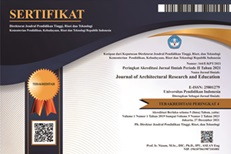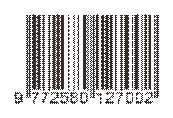The Gap between Architecture Education and Architectural Profession in Iran
Abstract
Many graduates of architecture attracted to the job market find a profound gap between what they have learned in college and what is being done in their career in Iran. The educational problems that make architecture graduates inefficient in the job market are identified. Then solutions are offered to reduce the gap. Four types of questionnaires were distributed to the last year undergraduate students, professors of architecture schools and professional architects and their answers and suggestions were collected. The results show that there are some solutions for bringing architecture education closer to architectural profession: 1. participatory education, 2. establishment of non-governmental organisations, 3. linking faculties of architecture with architectural offices, and 4. revision of undergraduate curriculum of architecture.
Full Text:
PDFReferences
Afsharnaderi, K. 1995, The role of architect. Proceedings of the 1st Congress on the History of Architecture and Urbanism in Iran, Bam, 293-300. [In Persian]
Alipour, L. 2019. Intuitive and logical way of thinking in the education of architectural design courses. International Journal of Architectural Engineering & Urban Planning, 29(2), 161-170.
Beyraghi, S. 2018. Semiotics of behavioral settings in educational spaces, emphasizing the social value of spaces (Case study of Islamic Art Faculty and Architecture and Art Faculty of Azad University of Tabriz). International Journal of Architectural Engineering & Urban Planning, 28(2), 117-133.
Darrehzarkeshi, M. H. (2016). Design of Yazd faculty of art and architecture with emphasis on the role of geometry in enhancing the quality of architecture education. Master Thesis. University of Science and Art, Tehran. [In Persian]
Emam, M., Taha, D. & El Sayad, Z. (2019). Collaborative pedagogy in architectural design studio: A case study in applying collaborative design. Alexandria Engineering Journal, 58(1), 163-170.
Fami, H. S., Aghapour, S. & Alambeygi, A. (2010). Identification of barriers and problems of job oriented learning formation among agricultural students of the University of Tehran. Iranian Journal of Agricultural Economics and Development Research, 41-2(2), 219-229.
Hedayati, M. & Seyedian, S. A. (2014). The pathology of architectural education in the higher education system. Proceedings of the 2nd National Conference on Architecture, Restoration, Urban Development and Sustainable Environment. Hamedan, 1-15.
Hojjat, E. (2002). A word of time. Fine Arts, 12(13), 50-58. [In Persian]
Hojjat, E. (2003). Architecture education and worthless values. Fine Arts, 14(14), 63-70. [In Persian]
Hojjat, E. (2012). Little architects: architecture education from chest to chest to shoulder to shoulder. Iranian Journal of Engineering Education, 14(56), 37-53. [In Persian]
Hojjat, E. (2014). Four season of foreign architecture education on the ups and downs of architectural education in Iran. Proceedings of the 5th National Conference on Architecture Education. Tehran, 1-6. [In Persian]
Kianersi, M. (2017). Developing design thinking using self-regulated learning in basic architecture design training. Master Thesis. Art University of Isfahan, Isfahan. [In Persian]
Legény, J., Špaček, R. & Morgenstein, P. (2018). Binding architectural practice with education. Global Journal of Engineering Education, 20(1), 6-14.
Mahdavinejad, M., Ghasempourabadi, M., Ghaedi, H. & Nikhoosh, N. (2012). Formal architectural education and training professional technicians (case study: Iran). Procedia-Social and Behavioral Sciences, 51, 454-458.
Moosavi, M. S. & Shoarian Sattari, V. (2013). Educational challenges of sustainable architecture in higher education system of Iran. Life Science Journal, 10(2s), 144-149.
Nadimi, H. 2010. Master and apprentice method, from another viewpoint. Fine arts, 2(44), 27-36. [In Persian]
Rauf, H. L., Shareef, S. S. & Ukabi, E. (2019). Understanding the relationship between construction courses and design in architectural education. International Journal of Recent Technology and Engineering, 8(3), 3201-3207.
Rifaat, S. I. (2019). The multidisciplinary approach to architectural education: bridging the gap between academic education and the complexities of professional practice. IOP Conference Series: Materials Science and Engineering, 471(8), 082067.
Rodriguez, C., Hudson, R. & Niblock, C. 2018. Collaborative learning in architectural education: benefits of combining conventional studio, virtual design studio and live projects. British Journal of Educational Technology, 49(3), 337-353.
Sadraei, G. (2012). Architecture Faculty of Shiraz University of Arts with emphasis on interaction of education and profession. Master Thesis. University of Shiraz, Shiraz. [In Persian]
Salama, A. M. (2009). Transformative pedagogy in architecture and urbanism. Solingen: Umbau-Verlag.
Salazar Ferro, C., Artega Arredondo, I., Rodriguez, C. M. & Nadal, D. H. (2019). Active learning in architectural education: A participatory design experience (PDE) in Colombia. International Journal of Art & Design Education.
Sattari Raouf, E. (2008). Factors influencing the process of skills in architectural education. Proceedings of the 3rd Conference on Architecture Education. Tehran, 177-191. [In Persian]
Saghafi, M. R. 2015. A comprehensive model for architecture education: an integration of in-person and virtual learning environments. Education Technology, 9(4), 253-263. [In Persian]
Saghafi, M. R., Mozaffar, F. & Mousavi, S. M. 2015. The effect of direct teacher-student involvement training on learning process in Introduction to Architecture Design Course. Restoration and Architecture of Iran, 5(10), 79-90. [In Persian]
Sardashti, S., Mozaffar, F. & Shafaei, M. 2020a. The efficacy of using critical pedagogy as a teaching method in master design course (1) on graduate students' motivation. Armanshahr, 13(29), 31-43.
Sardashti, S., Shafaei, M. & Mozaffar, F. 2020b. Application of critical education in architecture education system (case study of a Master's Degree Architecture Class at Gorgan Azad University). Technology of Education, 13(4), 709-725. [In Persian]
Sonawane, A. M. H. & Gokhale, V. A. A. (2016). Critical view on pedagogical dimension of architectural education in India. International Journal of Engineering Research and Applications, 6(1), 90-97.
Yalçın, M. A. & Ulusoy, M. (2015). Personal and professional attitudes of architecture students. Procedia-Social and Behavioral Sciences, 174, 1820-1828.
Zhao, S., De Angelis, E. & Ma, D. (2018). Reflecting on the architecture curriculum through a survey on career switching. Design and Technology Education, 23(1), 1.
DOI: https://doi.org/10.17509/jare.v2i2.28026
Refbacks
- There are currently no refbacks.
Copyright (c) 2020 Saba Hejazi

This work is licensed under a Creative Commons Attribution-NonCommercial-ShareAlike 4.0 International License.

This work is licensed under a Creative Commons Attribution-ShareAlike 4.0 International License.








